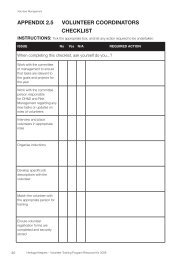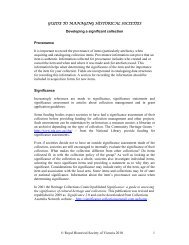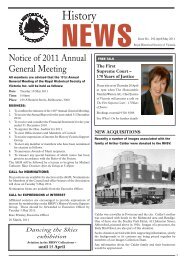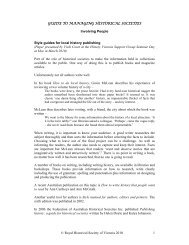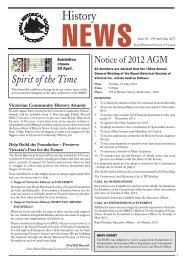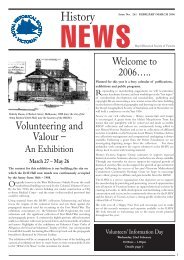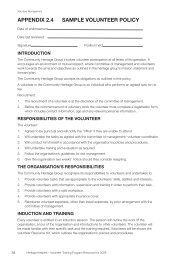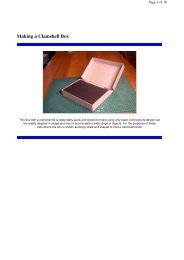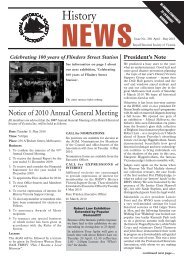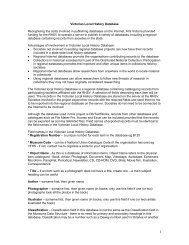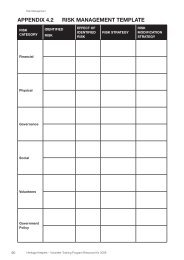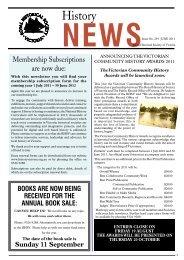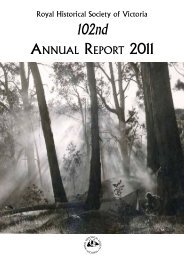Melbourne's streets and lanes - Royal Historical Society of Victoria
Melbourne's streets and lanes - Royal Historical Society of Victoria
Melbourne's streets and lanes - Royal Historical Society of Victoria
Create successful ePaper yourself
Turn your PDF publications into a flip-book with our unique Google optimized e-Paper software.
Melbourne’s <strong>streets</strong> <strong>and</strong> <strong>lanes</strong>: what’s in a name?A’BECKETT STREET Sir William A’Beckett, Port Phillip Resident Judge from1845, <strong>and</strong> <strong>Victoria</strong>’s first Chief Justice (D1).ALBION ALLEY The Albion Hotel in Bourke Street was the city terminus <strong>of</strong>Cobb & Co. coaches (F3).ALFRED PLACE After migrant ship or for birth <strong>of</strong> Prince Alfred, 6 August 1844,who visited Australia as Duke <strong>of</strong> Edinburgh 1867-1868 (H4).ATHENAEUM PLACE Named for Athena (Greek Goddess <strong>of</strong> Wisdom), theAthenaeum was the rebuilt Mechanics Institute; now hosts a library, club<strong>and</strong> theatre (G4).BANK PLACE Bank <strong>of</strong> Australasia built Collins Street premises in 1840 onl<strong>and</strong> purchased from CH Ebden. In 1858 rebuilt on Queen Street corner (D4).BAPTIST PLACE Built 1846, the original brick Collins Street chapel wasdesigned by John Gill, <strong>and</strong> its Corinthian portico, designed by Reed <strong>and</strong> Barnes,was added in 1862 (G4).BENNETTS LANE Robert Bennett MLA, Lord Mayor <strong>of</strong> Melbourne, 1861-62 (H2).BLIGH PLACE Merchants Bligh & Harbottle operated from premises in LittleFlinders Street (E5).BLOCK PLACE Access to Block Arcade (1893). ‘Doing the Block’ was thefashionable afternoon shopping <strong>and</strong> social promenade along this section <strong>of</strong>Collins Street (F4).BOND STREET Import merchants established bonded warehouses there afterMelbourne was granted full Customs port status in 1840 (E5).BOURKE STREET Sir Richard Bourke, NSW Governor 1831-38. While visitingPort Phillip in 1837, he named Melbourne <strong>and</strong> its major <strong>streets</strong> (B3).BOWEN STREET Named for Sir George Bowen Governor <strong>of</strong> <strong>Victoria</strong> 1873-79, the street was closed in 1950 <strong>and</strong> incorporated into grounds <strong>of</strong> RMITUniversity (G1).BRIEN LANE Opposite the former Eastern Market, butcher Joseph Briencarved out his business from 1848 (H3).BULLENS LANE Clothiers Frederick Bullen <strong>and</strong> Son, <strong>of</strong> Little Bourke Street,1880s (G3).CALEDONIAN LANE Caledonian Hotel, near corner Swanston <strong>and</strong> LonsdaleStreets, originally a 13-room house built by Presbyterian minister JP Clowin 1839 (F3).CARSON PLACE Featuring an elaborate facade, Carson’s quality footwearshop in Collins Street prospered in the gold-rush (F4).CELESTIAL AVENUE A name associated with ancient China’s Celestial Empire,ruled by heavenly beings (G3).CHAPTER HOUSE LANE Robert Hoddle included the lane when surveyingthe site in 1848 for St Paul’s church, rebuilt as the Cathedral in the 1880s (G5).CHURCH STREET AND LANE St James Church <strong>of</strong> Engl<strong>and</strong> estab. 1839, wasrelocated from William Street to King Street, West Melbourne in 1913 (C4).CLEVE LANE Cleve Bros. built bonded warehouse in Lonsdale Street in 1854,exp<strong>and</strong>ed business to King Street corner in 1862 (B3).CLUB LANE Rear access to the Melbourne Club (estab. 1838). Renamed fromCollins Lane after the Club’s Collins Street premises were built in 1859 (J4).COATES LANE EAST Grazier Walter Coates purchased a property on theYarra’s northern banks, 1840 (J4).COHEN PLACE Cohen’s Pawnbroker, Little Lonsdale Street, <strong>and</strong> CohenBrothers Upholsterers, Lonsdale Street, located east <strong>of</strong> Elizabeth Street (H3).COLLINS STREET Comm<strong>and</strong>ant Lt-Colonel David Collins ab<strong>and</strong>oned 1803-4convict settlement, near today’s Sorrento, to establish Hobart Town. Escapedconvict William Buckley remained behind (B4).COROMANDEL PLACE Ship from Plymouth with 239 passengers arrived atPort Phillip July 1840 (H4).CORPORATION LANE Led to works depot <strong>of</strong> Melbourne City Council (H5).CROMBIE LANE A survival from the early 1850s, probably named for LonsdaleSt drapers <strong>and</strong> importers Crombie, Clapperton & Findlay (B3).CROSSLEY STREET Previously Romeo Lane, located near Shakespeare Hotellocated in Stephen (later Exhibition) Street (J3).CROWN PLACE Crown Hotel cnr. Lonsdale <strong>and</strong> Queen Streets (E3).CUSTOMS HOUSE LANE Begun in 1839 <strong>and</strong> completed 1859, the CustomsHouse (now Immigration Museum) was adjacent to deep anchorage atQueen’s Wharf (C5).DEGRAVES STREET Merchant pastoralist William Degraves built a steamdrivenflour mill on this site in 1851 (F5).DOWNIE STREET Est. 1884, JB Downie, importer <strong>of</strong> beer, spirits, machinery<strong>and</strong> Portl<strong>and</strong> cement, later moved company to Market Street (B5).DREWERY LANE Chemist Thomas Drewery was elected City Councillor forGipps Ward in 1851 (F2).DUCKBOARD PLACE Adjacent to Duckboard House, WW2 entertainmentcentre for troops (H5).EAGLE ALLEY An old right-<strong>of</strong> way from LaTrobe Street to Hawk Place <strong>of</strong>f KingStreet became Eagle Alley in 1890, a name now given to the whole ‘dogleg’ (B2).ELIZABETH STREET The once-timbered gully was possibly named to honourGov. Bourke’s wife who died at Parramatta in 1832 (F5).EQUITABLE PLACE Equitable Life Assurance <strong>of</strong>fices on Elizabeth-CollinsStreet corner were built by Dame Nellie Melba’s father, David Mitchell (E4).EXHIBITION STREET see STEPHEN STREETEXPLORATION LANE Little Lonsdale’s Exploration Hotel was possibly namedfor the doomed Burke <strong>and</strong> Wills Expedition 1860-1 (H2).FINLAY ALLEY Possibly for John Finlay, road contractor, pastoralist <strong>and</strong> later StKilda resident (E2).FLANIGAN LANE Architects John Flanigan snr <strong>and</strong> jnr designed the nowdemolished Eastern Market (E2).FLINDERS STREET In April 1802 navigator Capt. Matthew Flinders in theInvestigator claimed discovery <strong>of</strong> Port Phillip, but later acknowledged the priorarrival in February <strong>of</strong> the Lady Nelson under Acting Lieut. John Murray (C5).FRANCIS STREET Merchant politician JG Francis held the Trade <strong>and</strong> Customsportfolio in 1866 when the Government Shipping Offices were built frontingSpencer Street (A4).GEDDES LANE Engineer <strong>and</strong> machinist William Geddes operated from CollinsStreet premises (C5).GEORGE PDE Name changed from La Trobe Parade c1924 after the Henry GeorgeClub, named for the political theorist, established headquarters there (H5).GLOBE ALLEY Globe Hotel on corner Swanston <strong>and</strong> Little Bourke Streets (G3).GODFREY STREET Formed by 1880s subdivision, possibly named for developer(A4).GOLDEN FLEECE ALLEY Russell Street’s Golden Fleece Hotel (H3).GOLDSBROUGH LANE Richard Goldsbrough’s wool warehouse, built 1862 on theBourke-William Street corner (C3).GORDON PLACE Gordon House built 1883 as apartments then converted to arooming house is again an up-market hotel <strong>and</strong> apartments (J3).GRESHAM STREET Formed in late 1880s, the name was first listed in 1933 (C3).GRIFFIN LANE Hay <strong>and</strong> corn merchant William Griffin was established in LittleCollins Street by 1856 (J2).GUESTS LANE Biscuit bakers TB Guest & Co. were in William Street from 1866(C3).GURNERS LANE Henry Gurner, Crown Solicitor from 1841-80, lived in WilliamStreet until 1854 (D4).HARDWARE STREET (AND LANE) Named for Hardware House 1927. Northern endwas formerly Wright Lane, named by 1857 (E2 & E3).HARPER LANE Merchant (<strong>and</strong> later Federal MP) Robert Harper, had a tea, c<strong>of</strong>fee,spice, flour <strong>and</strong> oatmeal business in Flinders Lane from 1865 (D5).HEAPE COURT Benjamin Heape, pastoralist merchant, <strong>of</strong> Heape <strong>and</strong> Grice, LittleLonsdale Street (E2).HEFFERNAN LANE Rody Heffernan owned the Melbourne Hotel (later CentenaryHotel) in Lonsdale Street (G3).HENTY LANE The pastoralist Henty family established James Henty & Co., amerchant <strong>and</strong> shipping agency in Little Collins Street in 1851 (C4).HIGHLANDER LANE From <strong>Royal</strong> Highl<strong>and</strong>er Hotel in Flinders Street (C5).HOWEY PLACE Henry Howey, pastoralist <strong>and</strong> first purchaser <strong>of</strong> l<strong>and</strong> on the corner<strong>of</strong> Swanston <strong>and</strong> Collins Streets, 1837 (F4).HOWITT LANE Dr Godfrey Howitt’s renowned prefabricated wooden cottage <strong>and</strong>garden was at the top <strong>of</strong> Collins Street from 1840 (J5).JEFFCOTT STREET William Jeffcott, Port Phillip’s second Resident Judge, 1843-45 (B1).KING STREET NSW Governor 1800-06, Philip Gidley King, facilitated the discovery<strong>of</strong> Port Phillip opening <strong>of</strong>f strategic Bass Strait (B5).KIRKS LANE August stallion sales were a highlight <strong>of</strong> Kirk’s Horse Bazaar, one<strong>of</strong> several Bourke Street saleyards between Swanston <strong>and</strong> Queen Streets (E3).KITZ LANE Swiss-born wine merchant Louis Kitz had stores in Bourke <strong>and</strong> CollinsStreets <strong>and</strong> in Geelong (D4).KNOX LANE Behind the former John Knox Church in Swanston Street, now aconvention centre for Melbourne Church <strong>of</strong> Christ (F2).LA TROBE STREET Charles Joseph La Trobe, Port Phillip Superintendent 1839-50,<strong>Victoria</strong>’s first Lieut.-Governor 1851-54 (B1).LITTLE BOURKE STREET Sections were named Law Courts Place <strong>and</strong> Post OfficePlace for adjacent institutions (B3).LITTLE COLLINS STREET Section between Queen <strong>and</strong> William Streets was knownas Chancery Lane (B4).LITTLE LEICHARDT STREET German explorer scientist Ludwig Leichardtdisappeared on his fourth north Australia trip, 1848 (J2).LITTLE LONSDALE STREET Little Lon’s eastern end gained a notorious reputation;its western end including Mint Place adjoining the <strong>Royal</strong> Mint, was a morerespectable address (B2).LITTLE QUEEN STREET Synagogue Lane until 1868, the new name reduced‘annoyances’ directed at those attending Little Bourke Street synagogue (D3).LIVERPOOL STREET Formerly Juliet Terrace, companion to Romeo Lane (seeCrossley Street) it was renamed for Bourke Street’s Liverpool Hotel (J3).LONSDALE STREET Capt. William Lonsdale oversaw civil <strong>and</strong> military matters asPort Phillip Police Magistrate, 1836-39 (C2).LUSH LANE James Lush <strong>of</strong> Mowbray <strong>and</strong> Lush, drapers <strong>and</strong> importers in adjacentFlinders Lane (G5).MACKENZIE STREET Poss. for Alistair Mackenzie, who arrived in 1842 withappointment from Colonial Office as Sheriff. In 1851 he succeeded Lonsdale as<strong>Victoria</strong>n Treasurer (H1).MALTHOUSE LANE Samuel Burston’s five-storey steam <strong>and</strong> gas poweredmalthouse produced superior malt for brewing from 1869 (H5).MANCHESTER LANE Adjacent to Flinders Lane’s numerous fabric <strong>and</strong> s<strong>of</strong>t goodswarehouses (F5).MARKET STREET A market square fronting Collins Street from 1842, the WesternMarket provided covered accommodation from 1849 (D5).MARKET LANE Gas lit by 1860s, the Eastern Market provided fresh produce<strong>and</strong> lively entertainment on Saturday nights (H3).MCCRACKENS LANE McCracken’s Collins Street brewery produced stout<strong>and</strong> ales from 1851 until it became part <strong>of</strong> Carlton <strong>and</strong> United breweriesin 1907 (C4).MCILWRAITH PLACE Formerly Lilly Lane, after 1840s estate agent JamesLilly; John McIlwraith, manufacturer <strong>of</strong> plumbing goods <strong>and</strong> shipowner wasLord Mayor <strong>of</strong> Melbourne 1873-4 (J4).MCKILLOP STREET Named by 1856, probably for the Scottish accountant<strong>and</strong> estate agent, JP McKillop (E4).MITCHELL LANE First listed 1935, provided rear access to a new commercialbuilding, Mitchell House in Elizabeth Street (E2).MITRE LANE Haunt <strong>of</strong> artists, lawyers <strong>and</strong> writers, the high-gabled MitreTavern has been licensed since 1867 (D4).MONAGHAN PLACE Thomas Monaghan <strong>of</strong> Queens Arms Hotel, cnr.Swanston Street <strong>and</strong> Flinders Lane from 1845 (F5).NIAGARA LANE Niagara Hotel on Lonsdale Street was named in 1856 forthe ship on which its original owners arrived (E3).PARK STREET Formed c1877 opposite Flagstaff Gardens allowing accessbetween LaTrobe <strong>and</strong> Little Lonsdale Streets (B2).PAYNES PLACE Renaming <strong>of</strong> an old lane in 1909 after John Payne <strong>of</strong> Payne’sBon Marche in Bourke Street (H3).QUEEN STREET Queen Adelaide, wife <strong>of</strong> William IV. Some consideredAdelaide Street a more honorable tribute to the King’s Consort (E5).RACING CLUB LANE Racing Club Hotel <strong>and</strong> <strong>of</strong>fices <strong>of</strong> the <strong>Victoria</strong>n RacingClub were located nearby (E3).RAINBOW ALLEY Rainbow Hotel, cnr. Swanston <strong>and</strong> Little Collins Streets(G4).ROSE ALLEY Named for King Street’s hay <strong>and</strong> corn merchant, Alex<strong>and</strong>erRose (B3).ROYAL LANE Near <strong>Royal</strong> Mail Hotel, cnr. Bourke <strong>and</strong> Swanston Streets,<strong>and</strong> Coppin’s Theatre <strong>Royal</strong> (G4).ROYSTON PLACE Formerly Were’s Alley after stockbroker, JB Were, arrived1839, whose name remains incorporated in a modern firm (F5).RUSSELL STREET After Lord John Russell, Secretary <strong>of</strong> State 1835-41, laterBritish Prime Minister (G5).SPENCER STREET Earl John Charles Spencer (Lord Melbourne’s formerChancellor <strong>of</strong> Exchequer as Lord Althorp), leader in House <strong>of</strong> Lords from1835 (A5).SPRING STREET A tribute to a verdant precinct; or more likely to ThomasSpring-Rice, Chancellor <strong>of</strong> Exchequer 1835-38 (J2).ST JAMES LANE See Church Lane (C4).ST PATRICKS ALLEY St Patrick’s Hall in Little Bourke Street hosted <strong>Victoria</strong>’sfirst Legislative Council, 1851-56 (D3).STAUGHTON ALLEY Pastoralist <strong>and</strong> banker Simon Staughton died 1865;stockholder in Flinders Lane 1841 (E5).STEPHEN STREET, LATER EXHIBITION STREET Sir James Stephen, ColonialOffice Under-Secretary 1836-47, was a great supporter <strong>of</strong> Australia’scolonization. Street name changed for the 1880 Great Exhibition (J4).SUTHERLAND STREET First listed 1865, possibly for solicitor RA Sutherl<strong>and</strong>(E2).SWANSTON STREET Capt. Charles Swanston, founder <strong>of</strong> Tasmania’sDerwent Bank, was a leader <strong>of</strong> the Port Phillip Association (F1).TATTERSALLS LANE Tattersalls Hotel <strong>and</strong> Tattersalls Club located nearbyin Bourke Street (G3).TAVISTOCK PLACE Named as lane by 1865, possibly after London’s TavistockStreet. Former Tavistock House was in Flinders Lane (D5).TEMPLE COURT PLACE Temple Court, home <strong>of</strong> the legal pr<strong>of</strong>ession, namedfor one <strong>of</strong> London’s Inns <strong>of</strong> Court (D4).THOMSON STREET Thomson & Co., brassfounders <strong>and</strong> coppersmiths,operated in Little Bourke Street c1880-1950 (D3).ULSTER LANE Ulster Family Hotel on corner <strong>of</strong> Spring <strong>and</strong> Little CollinsStreets (J4).UNION LANE Union Hotel in Little Collins Street in 1860s (F4).WILLIAM STREET King William IV who reigned 1830-37 left no heirs. Hisniece <strong>Victoria</strong> succeeded to the throne (C5).WILLS STREET Formed c1869 at the side <strong>of</strong> a new Crown L<strong>and</strong>s Office.Possibly honoring WJ Wills who died with RO Burke on the northernAustralia expedition (D1).WINDSOR PLACE Built in 1883 (architect Charles Webb), The Windsor(originally The Gr<strong>and</strong> Hotel), became a place <strong>of</strong> temperance as the Gr<strong>and</strong>C<strong>of</strong>fee Palace <strong>and</strong> re-emerged as the licensed Windsor Hotel in 1920 (J4).WURUNDJERI WAY Dedicated to the Wurundjeri, the traditional owners inthe area before European settlement; from wurund - river white gum trees<strong>and</strong> the jeri grubs found in them (A3).ZEVENBOOM LANE Dutch-born John Zevenboom launched the southernhemisphere’s first brush-making business (E2).© Copyright: <strong>Royal</strong> <strong>Historical</strong> <strong>Society</strong> <strong>of</strong> <strong>Victoria</strong>
Discover the history <strong>of</strong> Melbourne’s <strong>streets</strong> <strong>and</strong> <strong>lanes</strong>Taking a stroll downMelbourne’s<strong>streets</strong> & <strong>lanes</strong>Melbourne <strong>and</strong> its main <strong>streets</strong> from Flinders to Lonsdale <strong>and</strong>Spencer to Spring were named in 1837 by New South WalesGovernor Richard Bourke following his <strong>of</strong>ficial sanction <strong>of</strong> the PortPhillip settlement. Some names were drawn from his British mastersin Lord Melbourne’s second ministry 1835-1841. Under Bourke’ssuccessor George Gipps, the grid was extended northward to LaTrobe Street in 1839, with a north-west wing to <strong>Victoria</strong> Street in 1845.In Engl<strong>and</strong> during the period,William IV died in June 1837,Queen <strong>Victoria</strong> succeeded to thethrone, was crowned in July 1838<strong>and</strong> married Prince Albert on 10February 1840, the royal names allbeing given to city <strong>and</strong> near city<strong>streets</strong>.Before <strong>and</strong> after Port Phillipbecame the separate Colony<strong>of</strong> <strong>Victoria</strong> in 1851, privatesubdivisions created Melbourne’s<strong>lanes</strong> <strong>and</strong> alleys, giving side orrear access to buildings. Theirnames usually reflect people<strong>and</strong> places <strong>of</strong> commerce on aparticular site at a particulartime. A few persist from the1840s <strong>and</strong> 1850s, but in manycases rebuilding has resulted insuccessive name changes. Sincethe 1970s when site consolidationfor tower blocks intensified, many<strong>lanes</strong> <strong>and</strong> alleys have been closed<strong>and</strong> therefore no longer exist.The following listing is by no means complete. It represents atantalising glimpse <strong>of</strong> Melbourne’s heritage, its changing fortunes <strong>and</strong>the myriad stories <strong>and</strong> characters who have contributed to the names<strong>of</strong> the city’s <strong>streets</strong>, <strong>lanes</strong> <strong>and</strong> alleys.View from Parliament House c1880View from Parliament House steps 2004Cnr. Collins <strong>and</strong> Swanston Streets 1900Cnr. Collins <strong>and</strong> Swanston Streets 2004The RHSV gratefully acknowledges the support <strong>of</strong>the Office <strong>of</strong> the Surveyor General <strong>Victoria</strong>, KiplingsCommunications <strong>and</strong> Melway in the production <strong>of</strong> thisbrochure.Produced by:The <strong>Royal</strong> <strong>Historical</strong> <strong>Society</strong> <strong>of</strong> <strong>Victoria</strong>239 A’Beckett Street Melbourne VIC 3000Telephone: (03) 9326 9288Facsimile: (03) 9326 9477Email: <strong>of</strong>fice@historyvictoria.org.auMelbourne’sStreets & LanesDiscover Melbourne’s history at a glanceRHSV DISCOVERY SERIES No. 2www.historyvictoria.org.au



